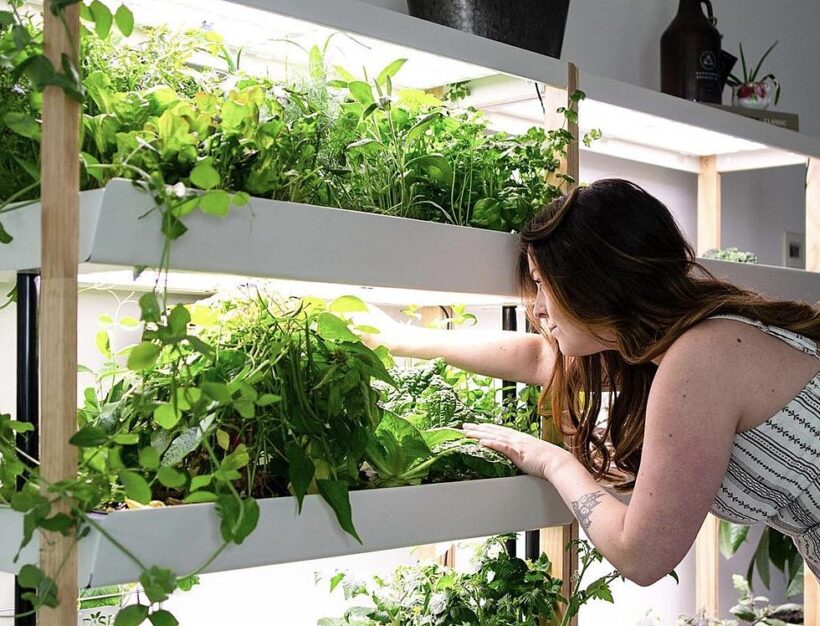
Hydroponic is a method to grow a plant without soil. The idea of the hydroponic method is to grow plants on water instead of growing plants in soil like the traditional way. The hydroponic method is popular due to its effectiveness and efficiency in planting plants such as vegetables, fruit, and herbs. The hydroponic can be applied both indoors and outdoors.
Indoor Hydroponic Garden
Indoor Hydroponic is a controlled and technology-driven system that is allowing you to grow plants without soils in the indoor environment. In the indoor hydroponic garden setup, the root of plants is supported in medium and the plants receive the essential nutrients directly from the water that’s already mixed with nutrients.
The indoor hydroponic garden is designed to provide optimal conditions for plant growth. The indoor hydroponic garden also allows you to cultivate a wide variety of crops for a long time, regardless of external conditions such as weather and climate.
Kind of Indoor Hydroponic
1. Deep Water Culture (DWC)
Deep Water Culture (DWC) is a simple and popular indoor hydroponic garden. The highlight of using the Deep Water Culture system is to make sure that the roots are underwater. This system uses a raft-like substance as media for holding the plant in the solution tank. The nutrient water is gradually moved through the tanks from the sump so the nutrients are slowly delivered to the plants.
2. Nutrient Film Technique (NFT)
Nutrient Film Technique (NFT) is one of the hydroponic planting techniques that use a nutrient circulation system. The system consists of a sloped channel or tubing where a thin film of nutrient water flows over the roots. The plants are placed in small containers with their roots exposed to the nutrient solution film.
3. Aeroponic
Aeroponic is a hydroponic system that makes the plant roots suspended in the air where the nutrients are delivered through the misted nutrient solution. This system provides high oxygen for the plant that is promoting rapid growth. This system also expensive, but it also really places efficient.
4. EBB & Flow (Flood and Drain)
EBB and Flow system periodically flood the root zine with nutrient solution and then drain it back to the reservoir. This system cycle can provide oxygen to the roots during the drainage period. This method also uses a tube as a water container to prevent ruining the plants and fruits.
See also : Improve Interior With Slab Jacking
5. Aquaponic
The aquaponic system is a combination between the hydroponic system and aquaculture. Aquaponics allows the plant to absorb the nutrient water that comes from the fish waste and the nutrient. The plants also help filter the water to keep it clean for the fish.
6. Smart and Automated System
Some modern indoor hydroponic setups integrate technology with technology that can work automatically. The smart and automated system allows remote monitoring and control of environmental factors through software applications and smart interfaces.
The choice for the indoor hydroponic system depends on some factors such as the availability of the space, the number of plants, type of the crops, and the level of experience you have. Each of the indoor hydroponic systems has its advantage and disadvantage. To know more about the information regarding the hydroponic garden you can visit Tophydroponicgarden.com.
Indoor Hydroponic and Outdoor Hydroponic
Both the indoor hydroponic garden and the outdoor hydroponic garden allow you to cultivate crops without soil. But they are different in terms of their environmental condition, management, and advantages. There are some differences between the indoor hydroponic garden and outdoor hydroponic garden.
Indoor Hydroponic Garden
1. Controlled Environment
An indoor hydroponic garden allows you to control some environmental factors such as temperature level, light, humidity level, and nutrient delivery. The total control of the environment allows you to do year-round cultivation and optimum growth condition for the plant without worry about external conditions such as weather.
2. Lighting
Artificial light is necessary for indoor hydroponic to replace natural sunlight. Without artificial lighting, the plant inside an indoor hydroponic garden can’t have enough energy to do photosynthesis
3. Space Efficiency
An indoor hydroponic garden can be designed to maximize the space. Indoor hydroponics often use vertical gardening to cultivate more plants in a smaller area.
4. Year-round Cultivation
The controlled environment and artificial light allow you to have a year-round cultivation plant system and overcome seasonal and weather limitations.
5. Protection from Pests and Diseases
The indoor hydroponic garden has less risk to get the disease from the pest that is commonly found in outdoor gardens.
6. Technology Integration
Indoor hydroponic gardens can be integrated with smart control technology for remote management and monitoring of the environment.
7. Plant Variety
Indoor hydroponics have a wider variety of species of plants to grow indoors, including some varieties that are not suitable to grow in your local climates.
Outdoor Hydroponic Garden
1. Natural Sunlight
Outdoor hydroponic gardens use natural sunlight to light the plants during the day. This light is a free and abundant source of light for the plants.
2. Seasonal Limitation
An outdoor hydroponic garden is limited to the season and weather. The change of season or extreme weather conditions might ruin your plant. You need some adjustments and setting to protect your plant to keep it surviving.
3. Energy Efficiency
Natural sunlight can reduce the cost of electric bills because during the day you don’t have to use artificial sunlight.
4. Less Control Over Climate
An outdoor hydroponic garden has lesser control over the level of humidity, temperature, and light quality compared to an indoor hydroponic garden.
5. Direct Nutrient Uptake
Plants in outdoor hydroponic systems can take advantage of rainwater and nutrient from the environment.
6. Sustainability Consideration
Outdoor systems is benefited from the natural ecology process such as rainwater collection, and nutrient cycling. Those can help to contribute to the sustainability of the plant.
The consideration of choosing whether to choose an indoor hydroponic garden or an outdoor hydroponic garden depends on some factors such as spaces, climates, and the type of plant that you want to grow. The indoor hydroponic garden might have some advantages such as a total control environment, year-round cultivation, and a wider variety of plants that can grow.

